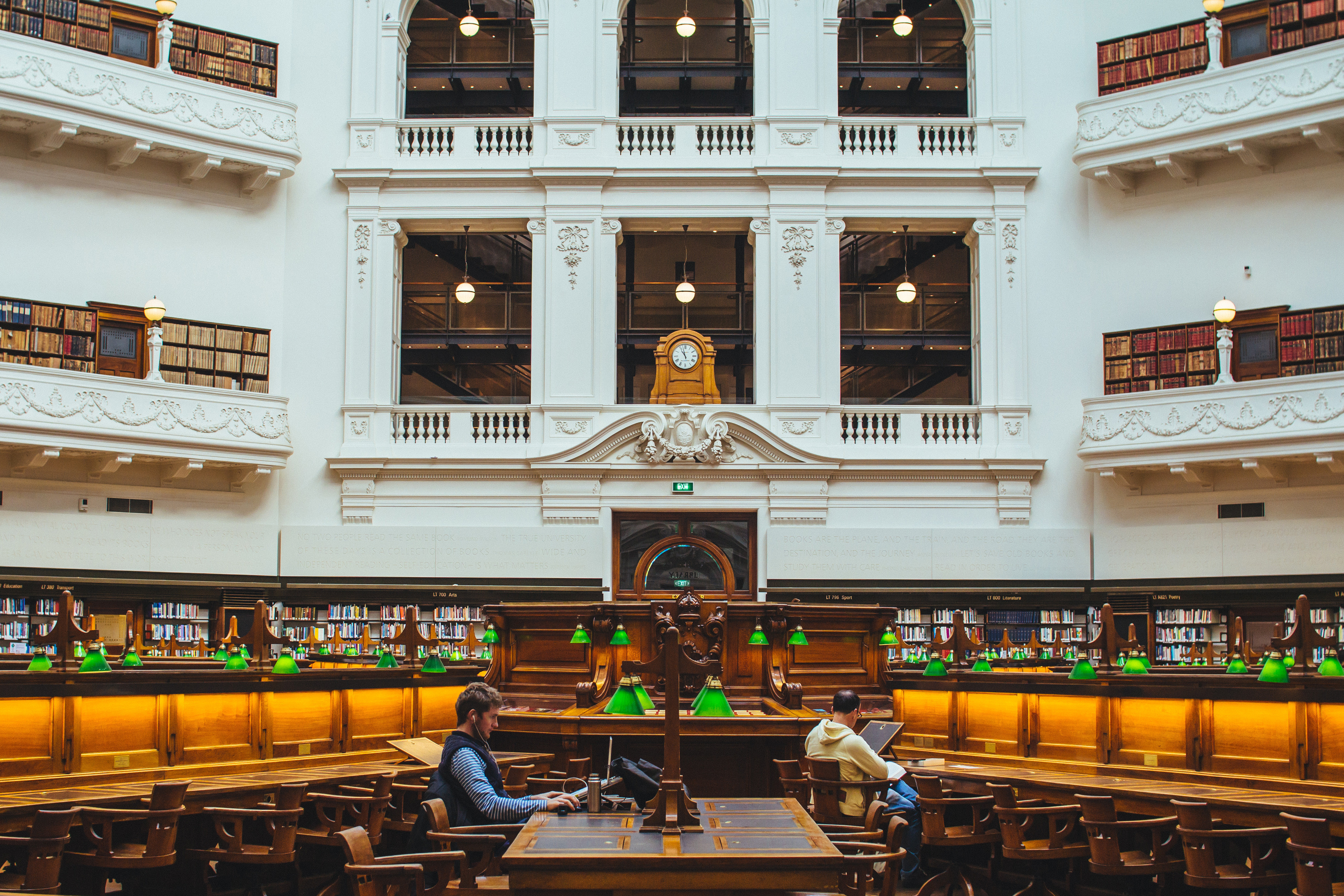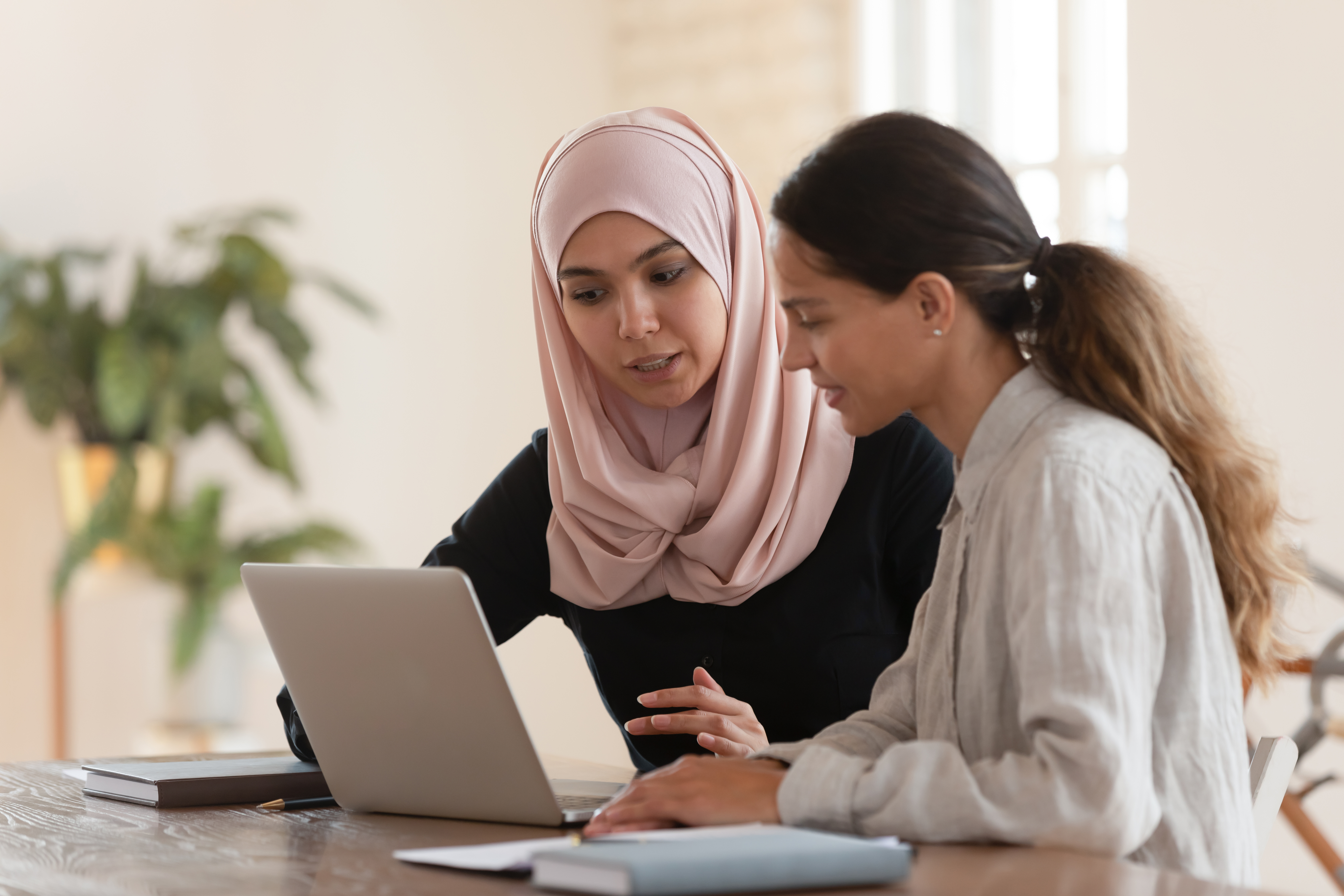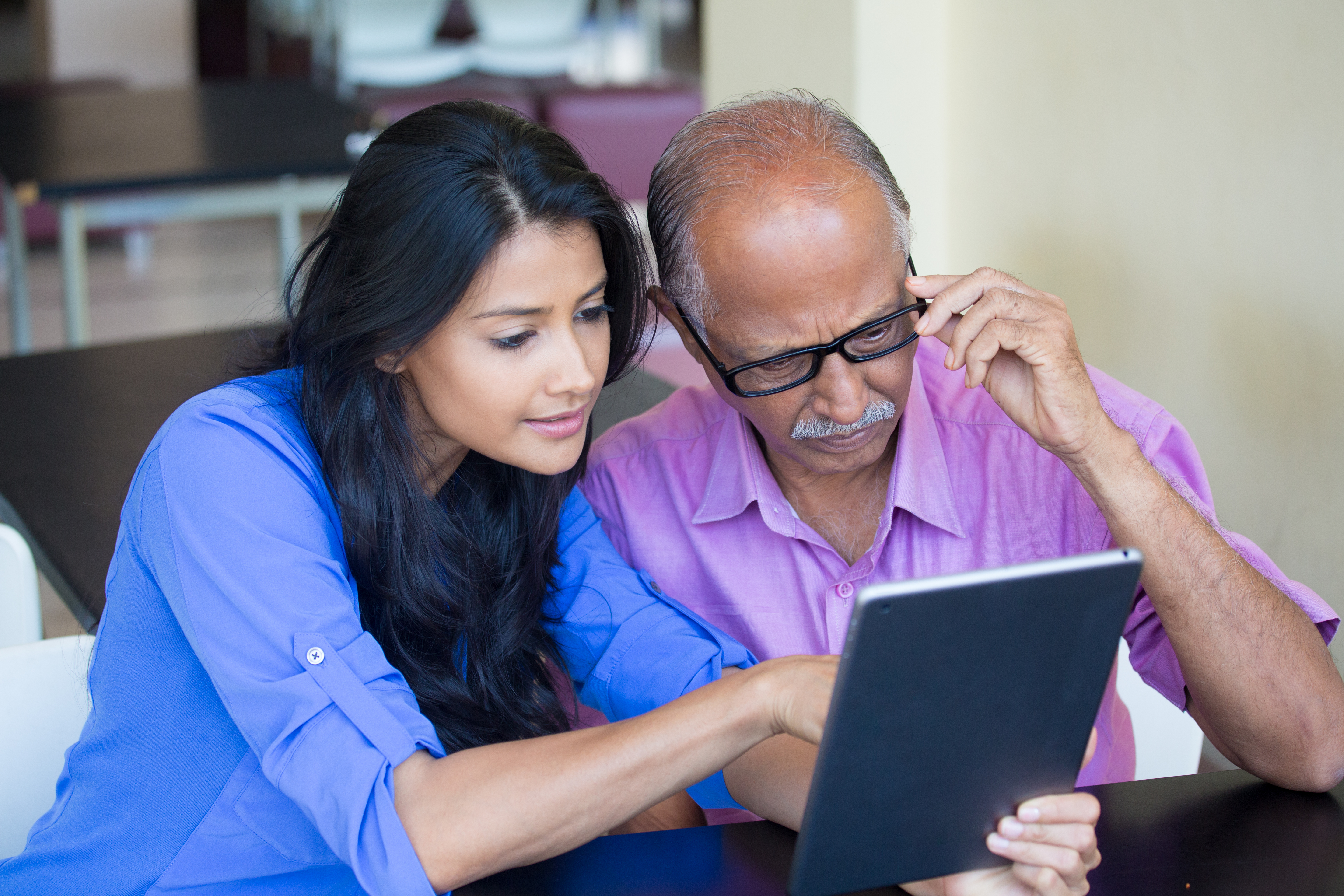- Date:
- 17 Oct 2022
Why have a Digital Inclusion Statement?
Introduction
The Victorian Government is investing in our digital future to help make Victoria the most connected state in Australia.
The COVID‑19 pandemic has highlighted the importance of access to the online world.
Since March 2020, many Victorians have worked and studied from home. Businesses, service providers, community organisations and governments have moved online or expanded their digital presence.
We connect with families and friends online. It’s how we work, learn and volunteer. It’s how we grow our businesses. It’s how we access services, including from the Victorian Government.
The pandemic has reinforced the importance of digital tools and platforms in our personal, educational and professional lives.
The Victorian Government is investing in technology, infrastructure, and skills to improve our online access through a range of initiatives while upskilling Victorians and improving online safety.
For example, we have invested $58 million to improve mobile phone services across the state, in partnership with industry and the Commonwealth Government. In October 2022, we announced a $300 million investment to deliver 1,108 mobile infrastructure projects, which will improve the quality and consistency of mobile coverage where Victorians live and work.
By acting now, we're making sure all Victorians can benefit from our state's bright future.
We’re working across government and with businesses, councils, and communities to remove barriers so all Victorians can benefit from the economic, social, cultural, and community participation available in our online world.
We are setting clear, common goals, so no Victorian is left behind.
What is digital inclusion?
Digital inclusion means:
- access to high‑quality internet through physical infrastructure, such as broadband and mobile networks, and a device to use the internet, such as a mobile phone, tablet, or computer
- technology and services are accessible and inclusive for everyone, including people with low digital literacy or with low English proficiency
- affordable digital services and technologies
- the ability, skills, and confidence to use the technology and engage online
(Based on the Australian Digital Inclusion Index framework.)
Digital safety is also essential. People need to know how to keep their information safe, and avoid scams and misleading information.
Seeking Victorians’ views
To better understand mobile and broadband connectivity challenges faced across the state, the Victorian Government undertook extensive engagement with Victorians to inform the ongoing rollout of the Connecting Victoria program. While consultations with communities and businesses will continue throughout the program, our initial findings were clear.
Businesses and communities relied heavily on digital technology throughout the pandemic and said this was likely to increase. However, some people couldn’t participate online because they didn’t have reliable, high‑speed internet. Some Victorians, including older people, regional residents, and communities experiencing disadvantage, didn’t have the technology
or the skills to use it.
Affordability was also a problem, with some customers paying high prices for internet and mobile phone services. Others couldn’t afford a service at all.
How the pandemic changed the way we use technology
A 2021 Australian Communications and Media Authority consumer survey found more Australian adults used the internet compared with 2019.
For example, nearly all Australians (99 per cent) accessed the internet in the six months to June 2021. This was an increase from 90 per cent in 2019.
In 2017, research for Service Victoria found that 19 per cent of respondents chose not to use technology to connect with government. By 2021 this number had reduced to eight per cent.
Why does digital inclusion matter?
Benefits of digital inclusion
Digital inclusion helps build a strong economy and an inclusive society.
Digital inclusion allows us to communicate with friends and family, volunteer, find work or change jobs, gain skills and education, seek government support, and access financial, health, entertainment, goods, and other services, including timely information during emergencies.
It allows us to participate in our community, benefiting individuals and the economy.
Government services perform better when people have access to the online world, improving efficiency and helping to ensure no‑one is excluded.
For businesses, improving our online capabilities means:
- greater efficiency, productivity and cyber security
- access to new online markets
- business growth and innovation with better technology and more productive, capable workers
- reshaping traditional recruitment practices
All Victorians benefit.
Challenges of digital inclusion
We’ve seen the benefits and possibilities of interacting and working online during the pandemic. We’ve worked from home. We’ve learned and trained online. We’ve connected with family and friends on video calls. We’ve bought goods and services, attended medical appointments using telehealth, and found and shared public health information. Businesses and community organisations have rapidly adapted to the online world.
But not everyone could participate, and the benefits were not equally shared, adding to existing disadvantages.
Many things contribute to poor online access, including socio‑economic, educational, literacy, age, cultural and geographic factors. The most significant factor is low household income.
The most digitally disadvantaged Victorians are:
- people with low educational attainment
- people in low-income households
- Victorians with disability
- senior Victorians
- public housing tenants
- people who are not working
- regional Victorians
- First Peoples
Keeping Victorians safe online
Digital advancement brings risks.
Not everyone wants to use services online. For example, some people with cognitive disabilities may find it challenging to use some websites, and some older people may struggle with new technology. We must ensure people who don’t go online still have everything they need.
Emergencies are challenging and highlight the importance of resilient and accessible telecommunications services to connect people and share important messages.
Online threats can cause problems, and governments play a role in legislating, regulating, and educating people to reduce harm from privacy and security breaches, scams, fraud, and harassment.
Victoria’s Cyber Strategy 2021 was developed to support a cyber safe Victoria.
Everyone can support digital inclusion
Governments are working with the private and community sectors to improve online inclusion.
The Commonwealth Government regulates the industry and ensures all Australians can access adequate telephone and internet services.
The Victorian Government is investing to improve services to meet business and community needs. We are investing through partnerships with industry and the Commonwealth Government, and through Connecting Victoria.
The $550 million Connecting Victoria program is improving online access by upgrading infrastructure in regional Victoria and outer suburban Melbourne. It will improve broadband and mobile coverage by seeking co‑funding from telecommunications providers and the Commonwealth to better connect as many places as possible, as quickly as possible.
We are also working with local government to improve online services in places such as public libraries.
Industry and community organisations are working hard to improve online access across the state, creating new opportunities for their customers and clients. Many are keen to scale up their work and expand their reach.
Digital inclusion in Victoria
The Australian Digital Inclusion Index is the primary measure of digital inclusion and is calculated by looking at access, affordability, and digital ability across Australia’s population.
Victoria scores well overall on the Australian Digital Inclusion Index (ADII). In 2021, Victorian registered an ADII aggregate digital inclusion score of 72, above the national average of 71.1. We ranked equal second with Western Australia (72), below the Australian Capital Territory (77), and above other Australian states.
On the key measures, we performed best on affordability (93), followed by access (71) and digital ability (65).
However, the scores for access, affordability, and digital ability vary considerably across different groups in our community.
By looking at the details, we gain a deeper understanding of Victoria’s digital inclusion gaps.
The following information quickly highlights a key digital inclusion gap – regional Victorians are disadvantaged relative to metropolitan Melbourne. Connecting Victoria is a major investment targeting this gap.
Digital inclusion scores
- National average: 71.1
- Regional Australia: 67.4
- Metropolitan Australia: 72.9
Social housing tenants recorded an ADII score 9.6 points below the national average.
More than a quarter (25.1 per cent) of public housing tenants are mobile‑only users, compared with 11.4 per cent of private housing tenants.
11 per cent of the Australian population is highly excluded, registering an ADII score of 45 or below.
67 per cent of Victoria's lowest income group would have to spend more than 10 per cent of their household income to get suitable connectivity (compared with 14 per cent of Australians overall).
Victoria's 65+ age group has a digital ability score 46 per cent below the national average.
Our vision for Victoria’s digital future
Our vision is for all Victorians to access and use online technologies to connect, volunteer, work and learn, and deliver and use the services they need or want confidently, affordably, and safely.
This Digital Inclusion Statement identifies four priorities: access, affordability, digital ability and digital safety.
For each priority, we have identified actions, so:
- more people, businesses and communities can participate online
- online government services are easier to access
- online environments are safer
- people improve their digital skills and capabilities
This Digital Inclusion Statement sits under the Victorian Government Digital Strategy 2021‑2026, which is a broad vision and guide for government departments and agencies on the high‑level digital priorities for Victoria. This Digital Inclusion Statement details how we will deliver on two of the Digital Strategy’s key objectives: providing digital experiences that support and empower everyone; and advancing digital literacy and inclusion.
The Digital Inclusion Statement also aligns with the Inclusive Victoria: State Disability Plan (2022–2026) and its digital inclusion commitments. Under the State Disability Plan, the Victorian Government will undertake a research project that builds on the annual ADII report. This work will further inform the government’s understanding of digital inclusion issues experienced by people across Victoria, including people with disability, people living in regional and rural areas, people from lower socio‑economic communities and older people.
Target 17 of the National Agreement on Closing the Gap commits to Aboriginal and Torres Strait Islander people having equal levels of digital inclusion by 2026. The Digital Inclusion Statement reflects the government’s ongoing commitment to improving digital inclusion of Aboriginal Victorians.
Action 1
Increase online access via infrastructure and devices, reducing geographical disparities, and supporting better digital design.
Digital infrastructure and connectivity
Victoria’s online infrastructure challenges are well‑known and mainly affect businesses and communities in regional, rural and outer suburban areas.
While Victoria has a strong online connection, we have a large city‑country divide. Smaller populations, fewer commercial opportunities, and higher costs make it less attractive for private investment in regional and rural Victoria, which means lower quality digital infrastructure.
Natural disasters and emergencies highlight the importance of reliable communications during these events and in recovery. During one severe weather event, Victorians lost access to 175,000 NBN services and 253 mobile towers, and 49 communities lost emergency phone services. High‑quality services are also crucial during global events, such as the pandemic.
Web accessibility
Accessibility means people can participate, regardless of their abilities or circumstances. It means websites and online services are designed and written in a way that is suitable for everyone, and support Victorians who use tools such as screen readers. Accessible, or universal, design also benefits:
- people with low literacy or low English proficiency
- people with slow internet or using older technologies
- new and infrequent internet users
- people using mobile devices
The World Wide Web Consortium has created Web Content Accessibility Guidelines for everyone to use. The Victorian Public Service follows the guidelines, but some businesses and service providers need support to meet accessibility requirements.
How we are improving access
- Connecting Victoria: Significantly improving mobile coverage and broadband quality, supporting businesses to grow and create new jobs by investing $550 million over six years, and leveraging co‑investment from industry and the Commonwealth Government
- Free public WiFi networks in regional Victoria: Supporting residents, businesses, students, visitors and groups experiencing disadvantage with free public WiFi networks in selected locations across regional Victoria
- Regional Digital Fund: Supporting small digital projects in, or for the benefit of, regional Victoria with a $3.5 million investment
- Public Libraries Funding Program: Investing $48.1 million in public libraries for collection items, information technology, library and outreach programs
- Victorian Mobile Program: Building more than 230 new mobile base stations across the state in partnership with the Commonwealth’s Mobile Black Spot Program and industry
- Lifting the Digital Experience of Connected Learners: Improving the bandwidth to all Victorian government schools with a $59.9 million investment over four years
- Service Victoria: A free, easy‑to‑use mobile app and website that helps the Victorian Government to deliver services digitally, ensuring they are accessible
Over the next six to 12 months, we will:
- continue to implement Connecting Victoria in partnership with industry to deliver an unprecedented state investment and improve mobile and broadband access in Victoria’s regional, rural, and outer suburban areas
- work to secure Victoria’s share of new Commonwealth Government funding opportunities
- gather Victorian digital inclusion data through Connecting Victoria to support program delivery, evaluation and future needs analysis. This will build on the ADII framework
- work to ensure websites meet accessibility standards under the World Wide Web Consortium Web Content Accessibility Guidelines (WCAG 2.1) with translation available for linguistically diverse users
- invest $29 million over two years through the Single Digital Presence initiative to improve government resources, making it easier for Victorians to find, understand and use information

Snapshot: Improving mobile connectivity in regional Victoria
The Victorian Government has invested $58 million through the Victorian Mobile Program to improve mobile phone services across the state, in partnership with industry and the Commonwealth Government.
So far, Victoria has funded more than 230 new mobile base stations under this program to improve liveability and public safety for communities.
The base stations are being built in high‑priority areas that had little or no coverage. Most locations are prone to natural disasters, such as bushfires and floods.
In October 2022, we announced a $300 million investment to improve the quality and consistency of mobile coverage where Victorians live and work.
With over 1,100 upgrades expected, our investments are making real differences to local communities. For example, we have partnered with Telstra to invest $2.2 million to improve 4G mobile capacity and resiliency in Mallacoota. This will help the region recover from the 2019‑20 bushfires and give residents more secure access to safety information during emergencies.
Action 2
Help overcome cost barriers to digital services and devices.
The cost of digital technology
The pandemic has dramatically increased the importance of online services, which give people access to emergency information and services, help them to work and study, and connect them with family and friends.
However, the cost of digital technology is a barrier for some Victorians. The issue was highlighted when schools shifted to remote learning during the Covid‑19 pandemic, and thousands of devices and internet dongles were required to fill gaps where students had no access at home.
To overcome this barrier, governments and industry must support affordable digital access in the same way as other essential services, such as electricity and water.
How we are improving affordability
- Support for online education: 91,000 devices provided and permanently retained by families and 28,000 mobile data dongles made available to support students’ remote learning
- Living Libraries Infrastructure Program: Providing accessible, high‑quality library infrastructure, including digital infrastructure and affordable WiFi
- Free public WiFi networks in regional Victoria: Supporting residents, businesses, students, visitors and disadvantaged groups with free public WiFi networks in selected locations across regional Victoria
- Let’s Stay Connected Fund: Reduced isolation and loneliness during the pandemic through $1.3 million in grants for community organisations
- Staying Connected Self‑Advocacy Resource Unit: Invested $600,000 for IT equipment on loan through an IT library, and one‑on‑one phone support and training to support self‑advocates to stay connected and engaged with their communities
Over the next six to 12 months, we will:
- upgrade the free public WiFi networks in Bendigo and Ballarat, and continue these services for another seven years through a $3.6 million investment
- launch free public WiFi services in Ararat, building on the free public WiFi recently announced in Geelong and Latrobe
- invest $1 million in digital infrastructure upgrades in Cremorne

Snapshot: Improving access through public libraries
Libraries support digital inclusion for Victorians through:
- access: providing free WiFi to library users
- affordability: acting as distribution points for device loan schemes
- digital ability: providing and promoting digital capability courses
- digital safety: participating as members of eSmart Libraries.
eSmart Libraries is a national cyber safety initiative run by the Alannah and Madeline Foundation and the Telstra Foundation. It equips libraries, staff, and library users with the skills they need for smart, safe, and responsible use of digital technology.
Action 3
Develop targeted training and support to boost digital skills and online confidence.
Low digital skills
Digital skills are increasingly important, and many jobs require basic digital literacy. The pandemic has dramatically changed how we live and work, increasing our reliance on digital skills and contributing to existing inequality.
There are strong links between income, education and digital skills. Students from low‑income families are less likely to have the advanced digital skills they need for remote learning, and to support future education, training and employment.
Low digital skills can also lead to other types of exclusion, and prevent people from accessing government and other essential services.
How we are improving digital skills
- Tackling the digital divide to get Victorians into jobs: Delivering 4800 additional digital literacy and employability skills places through Learn Local providers with a $2.8 million investment
- Jobs Victoria: Supporting Victorians into sustainable jobs through pathways focused on digital literacy, digital skill development, and job opportunities through the Jobs Victoria online hub
- Digital Jobs Program: Equipping mid‑career Victorians with up‑to‑date digital skills with a $64 million investment
- Social Seniors program: Building senior Victorians’ technology skills with practical, hands‑on weekly workshops
- Upskill My Business: Partnering with industry and education providers to offer free courses, live and on‑demand events, and business resources to help Victorian businesses grow and thrive
- Digital Innovation Futures (DIF): Providing communities, businesses, and individuals access to information and events on digital skills and e‑safety via the DIF Online Event Hub and DIF Festival
- Women’s economic security programs: Supporting women at different stages of their employment pathway, including women from refugee or migrant backgrounds
- Small Business Digital Adaptation Program: Partnered with suppliers to offer $1200 rebates so small businesses could access digital tools to improve their websites, online marketing impact, cashflow services, jobs, and project management and stocktake systems
- Victoria’s Cyber Strategy 2021: Building a vibrant cyber economy by creating opportunities for strategic partnerships, promoting local job creation, and investing in cyber skills and expertise
- Code Like a Girl partnership: Partnering with Code Like a Girl to provide paid internships within government departments for women passionate about code and supporting women already in the public service to undertake Code Like a Girl’s School of Code
- Digital Master Class Series: Helping inner southeast Melbourne business owners improve their digital literacy. The series provides a starting point for business owners to establish or grow their digital presence
- Learn Local Refurbished Laptop Program: Providing refurbished laptops for pre‑accredited training through Learn Local organisations, promoting new digital skills and literacy places for thousands of disadvantaged Victorians
- iManage My Health project: Used clinically trained volunteers to support community access to telehealth in an inclusive and culturally appropriate environment to enable remote patient self‑monitoring through smartphones, computers, tablets, and other devices
Over the next six to 12 months, we will:
- provide additional places over two years for pre‑accredited digital literacy training through a $2.8 million program that improves access to digital training for adults through Learn Local
- provide 1000 refurbished laptops to Learn Local organisations across Victoria, while testing the sustainability of an ongoing Learn Local Refurbished Laptop Program
- deliver a 10‑Year Digital Roadmap for Schools highlighting the need for equitable and safe access

Snapshot: Building skills in diverse communities
People from culturally and linguistically diverse backgrounds have a range of experiences online.
For example, older people may have lower digital literacy or be less proficient in English. If they can’t access online services in plain English or languages other than English, they may avoid them. Young people may adapt quickly to digital services but face access or affordability barriers.
The Victorian Government invested $60,000 in the 2020/21 Victorian Budget through the Metropolitan Partnerships to support Neighbourhood Houses to deliver the Multicultural Digital Inclusion Project. The project provides a practical and agile response to enabling digital inclusion for young and elderly people from culturally and linguistically diverse communities and other groups who experience financial barriers to digital access. The project is engaging with five Neighbourhood Houses in inner Melbourne suburbs to deliver short courses, including focusing on mentoring and cultivating peer leaders to address digital inclusion gaps.
The approach builds on the strength of Neighbourhood Houses’ established relationships with community members and the sector’s community development approach. Funding to five houses across the Inner Metro region is enabling the development of local programs to meet the bridge the digital divide and needs of specific local culturally and linguistically diverse communities to work towards digital inclusion for all.
Action 4
Promote a safe online environment and prevent online harm and abuse.
Cybercrime
Increasing use of digital technology in Victoria creates new opportunities, but it also increases the risk of harm as experience has shown. These risks include scams or fraud, being threatened, bullied or trolled, and misuse of personal information or images. This can impact people’s health and wellbeing and deter them from going online.
Victorians reported 19,000 cybercrimes – an average of 52 a day – from July 2020 to June 2021. The threat of cybercrime may reduce our online activity if we are not confident about managing online risks.
People are also concerned about online abuse, including stalking, monitoring, psychological and emotional abuse, threats, and sexual harassment. People who experience family violence report being and feeling unsafe online, with perpetrators using digital technology to monitor, threaten, isolate and restrict them. Some people are at greater risk of online harm than others. For example, scams and other cybercrimes can disproportionately impact older people and people with lower English language skills.
How we are improving online safety
- eSmart (schools): All Victorian government schools can access the eSmart suite of programs free of charge. eSmart is an initiative of the Alannah and Madeline Foundation that aims to create a culture of smart safe, and responsible use of technology
- Enhancing Online Safety for Women: Addressing gendered cyberhate towards women and non‑binary people in the media, politics and sport
- Bully Stoppers: Supporting teachers, principals, parents and students to help put a stop to bullying using an online resource
- Bullying and cyber‑bullying policies in Victorian government schools: All Victorian government schools have a bullying and cyber‑bullying policy to support a safe learning environment
- Victoria’s Cyber Strategy 2021: Improving Victoria’s cyber resilience through the safe and reliable delivery of government services, creating a cyber‑safe place to work, live and learn, and building a vibrant cyber economy
- Digital Innovation Futures: Promoting cyber safety to developers and tech companies to make digital spaces safer and more inclusive through annual campaigns such as Safer Internet Day and eSafety Week
- Ageing Well in Victoria Action Plan: The Ageing Well in Victoria Action Plan reflects contemporary issues facing senior Victorians, including online safety, and sets out the Victorian Government’s actions on these issues
- Responding to serious data breaches: The Commonwealth Government is responsible for data breach legislation for private organisations. However, the Victorian Government will monitor and respond to serious breaches by liaising with relevant agencies to minimise the harm these crimes can cause
These initiatives complement Commonwealth Government initiatives to improve digital safety, such as Scamwatch and the e‑Safety Commissioner.
Over the next six to 12 months, we will:
- protect Victoria’s public service from cyberattacks by investing $51 million over four years to improve cybersecurity controls and early risk detection (Victoria’s Cyber Strategy 2021, Mission 1)
- improve cyber awareness throughout the community, and bring together experts from across industry, education, and government to provide insights on cybercrime (Victoria’s Cyber Strategy 2021, Mission 2)
- introduce new Child Safe Standards, including enhanced requirements to manage the risk of child abuse in online environments
- support the community sector to build digital capability via the Connecting Up Conference and Not‑for‑profit Tech Awards
- foster the growth of a vibrant cyber economy to support the creation of jobs in cyber, that will in turn reduce the community impact and harm associated with cybercrime
- continue to engage with the Commissioner for Senior Victorians in his review and provision of advice about how to improve the levels of digital connectedness for senior Victorians. This will include a review of priority issue areas such as improving digital ability and building confidence, affordability concerns and addressing privacy and scamming protections

Snapshot: Keeping Victorians safe online
Victoria’s public library network runs the Social Seniors program, which builds the digital skills of people aged 60 and over.
Through a series of practical, hands‑on weekly workshops, the program teaches Victorians how to safely use digital tools to explore new interests, meet new people and stay connected.
Peer mentors assist people who don’t have the skills or confidence to participate online by using a learn‑by‑doing approach.
Social Seniors also teaches participants about online privacy and security so they can pay bills, bank online and access local services with confidence.
Our digital future
Our digital inclusion initiatives are making a difference. Together we’re building a more prosperous and inclusive Victoria.
